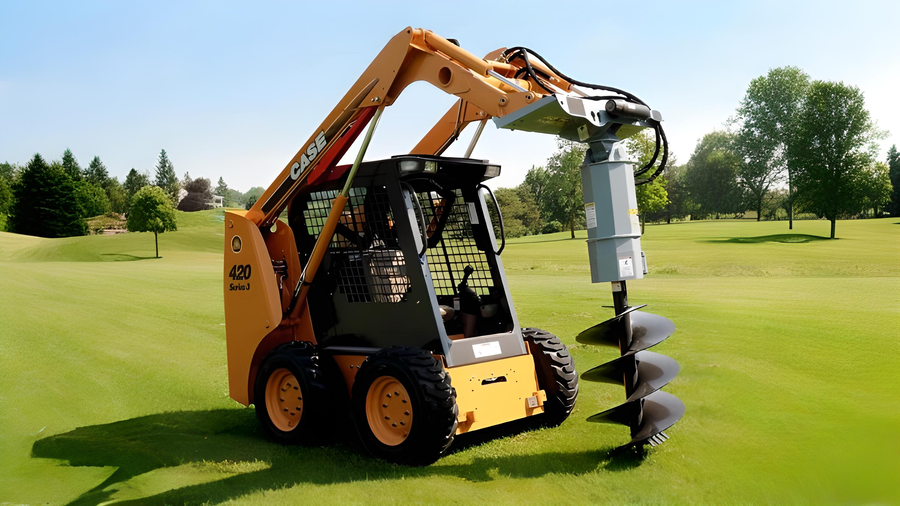What are Auger Bits Used for? Explore Different Applications

Table of Contents:
1. How Does a Skid Steer Auger Work?
2. Most Popular Auger Applications
3. What to Consider When Choosing an Auger Bit for Your Skid Steer?
4. Ensure You Get High-Quality Equipment
Any skid steer operator knows that if they need to dig holes in the ground, an auger attachment is the best tool for the job. Skid steer auger is one of the most popular construction equipment. Need to dig post holes or dig a well? Skid steer augers come with help! Additionally, they will perform any task with no damage to the surrounding area. What other jobs can you perform with the use of this attachment and how does it work? Find out the answers to all your questions below.
How Does a Skid Steer Auger Work?
Most of the augers are built similarly. Their motor is hydraulically driven. Thanks to its work the auger bit turns. The motor connects to the auger bit through a drive shaft. Through joysticks and levers, the operator adjusts the speed and changes the direction of operation. The process involves using hydraulic flow to make the auger bit spin.
It is up to the operator how quick the spin is and what its direction is. An additional feature, which some augers have, is the second motor. It serves to raise and lower the auger bit. Thanks to this, drilling a post hole at an angle is no longer an issue. The ultimate result of auger work is a clean, precise hole, ready to be used for many applications.
Most Popular Auger Applications
One of the skid steer auger's biggest advantages is its versatility. By purchasing one attachment, you can easily perform many jobs. Below you can find a list of only some construction and landscaping projects you can complete using a skid steer auger.
Tree Planting
Tree planting is one of the most important parts of many landscaping projects. It is also very daunting when done manually. Speeding up the process is the most important advantage of using a skid steer auger for tree planting. Before the tree is planted, there needs to be a hole in the ground in which the planting can take place. That is where the auger bit swoops in. Drill a hole, excavate rock, and soil, and plant the tree. No more hand digging! With an auger attachment, it is as easy pie.
Fence Post Installation
Sometimes you need an accurate tool that will drill holes precisely adjusted to your requirements. This happens, for example, when you need to install a fence or signposts. There is no better attachment than a skid steer auger to drill to the desired depth - even in frozen ground! And drilling such a hole takes no longer than a few seconds.
Stump Grinding
Augers are not only versatile themselves, but their range of applications can be boosted even more. One way to do it is by adding an extra extension or attachment to the auger bit. One such tool is a stump planer. Thanks to its rotating blades, this attachment can gradually shave down the stump in layers.
Pipe Laying
Precise dimensions of holes in the ground are essential when it comes to pipe laying. These need to be appropriately tailored for gas pipes, drainage, wires, and many more underground structures. There are few skid steer attachments that can work to such specifications, except augers.
Cement Mixing
Various hole digging is the most well-known auger application. However, by adding a cement mixing extension, you will not need yet another type of equipment for cement mixing. You can do it as effectively with the use of an auger, which ensures a smooth blend thanks to its rotating properties.
What to Consider When Choosing an Auger Bit for Your Skid Steer?
Since we already know what we can do having such a versatile tool as an auger, now it is time to try and find the tool that best suits your needs. How to do it? Simply, pay attention to some features listed below:
1. Hydraulic system - compare your skid steer's hydraulic flow rate to the attachment's needs. It is important for determining the speed of your attachment's work. Rotation will be faster when the hydraulic flow rate is high.
2. Torque - there are various torque ratings. If you are drilling large holes in solid ground, achieving the torque you need will result in slower operation. The choice of appropriate speed-to-torque ratio ensures the best digging results with optimal use of the equipment (no premature wear-down)
3. Depth - this feature depends on the model of the machine you are using. With standard attachments, the maximum depth you can achieve is usually 72 inches. Should you wish to dig deeper, the market offers depth-increasing extension attachments.
4. Diameter - the size of holes varies depending on the application. Pay attention to how wide holes you need to drill and choose the bit accordingly. For example, for fence posts, you will need an auger bit of a smaller diameter.
5. Drive - there are three auger drives available on the market: planetary drive (for hard ground conditions), chain drive (for average ground conditions), and direct drive (least powerful yet the most affordable).
Ensure You Get High-Quality Equipment
It must be remembered that the type of attachment depends not only on the type of application but also on the compatibility with your machine (be it skid steer, excavator, or tractor). However, no matter the type of attachment you choose, one thing remains unchanged - it must be of the highest quality to ensure productivity and efficiency.
Skidsteers.com carries a variety of American-made auger attachments for skid steers, excavators, and tractors. Consult one of our advisors before purchasing an auger to ensure it will be compatible with your machine.

